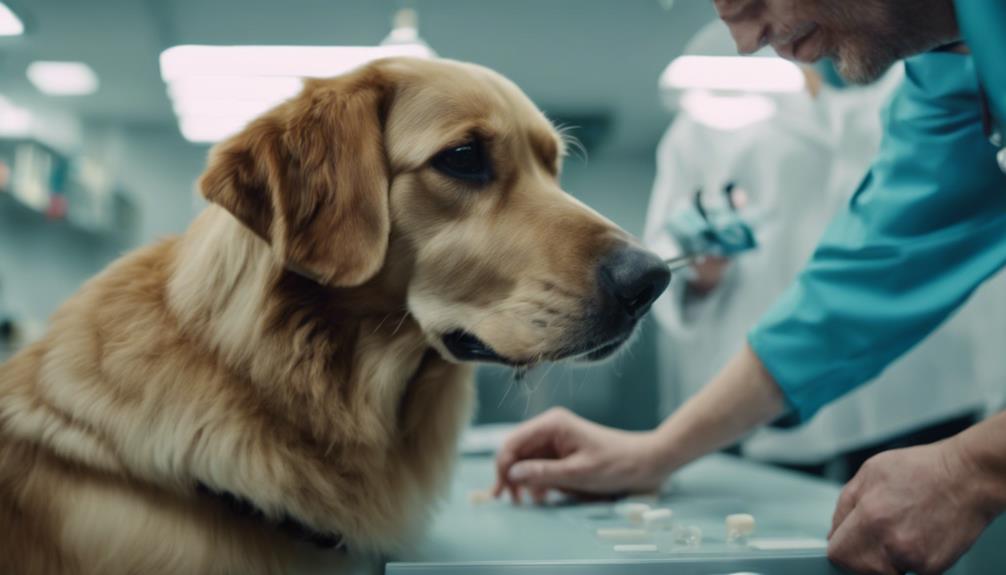In the realm of veterinary pharmacology, Prednisone emerges as a pivotal treatment option for a spectrum of canine health conditions, offering relief from inflammation, autoimmune disorders, allergies, and more.
However, the multifaceted nature of this drug brings along a range of potential side effects that necessitate careful consideration. Understanding the appropriate dosage, monitoring for adverse reactions, and being mindful of possible interactions with other medications are all critical aspects of utilizing Prednisone effectively in canine patients.
This comprehensive approach ensures optimal outcomes and underscores the importance of informed decision-making in veterinary care.
Key Takeaways
- Prednisone for dogs treats various conditions like arthritis, allergies, and autoimmune disorders to improve their quality of life.
- Monitoring for side effects such as increased thirst, weight gain, and weakened immunity is essential for the dog's well-being.
- Dosage varies based on the dog's condition and weight, typically ranging from 0.1-2 mg/kg administered once or twice daily.
- Precautions include watching for drug interactions, gradual tapering off, and regular veterinary check-ups to ensure safe and effective treatment.
Key Uses of Prednisone for Dogs
What are the primary applications of prednisone for dogs in veterinary medicine?
Prednisone, a corticosteroid, is commonly used in veterinary medicine to treat a variety of conditions in dogs. Its key uses include managing inflammation associated with conditions like arthritis, skin allergies, and inflammatory bowel disease.
Prednisone is also effective in managing autoimmune diseases such as lupus and autoimmune hemolytic anemia. Additionally, it can help control allergic reactions, asthma symptoms, and support cancer treatment by reducing inflammation and suppressing the immune system.
Veterinarians may prescribe prednisone to alleviate discomfort and improve the quality of life for dogs suffering from these conditions, but it is important to monitor for potential side effects and adjust the dosage as needed.
Common Side Effects in Dogs
Common side effects of prednisone in dogs may include increased thirst, urination, panting, weight gain, and a weakened immune system. While these side effects are common, they can vary in severity depending on the dog's individual response to the medication.
Increased thirst and urination are often noticed early on, while panting and weight gain may develop over time with prolonged use. The weakening of the immune system is a significant concern, as it can make dogs more susceptible to infections and illnesses.
Monitoring for these side effects is crucial, and any concerning symptoms should be promptly reported to the veterinarian to ensure the well-being of the dog throughout the course of prednisone treatment.
Dosage Guidelines for Prednisone

When administering prednisone to dogs, it is essential to adhere to specific dosage guidelines based on the dog's condition and weight to ensure optimal treatment outcomes and minimize potential side effects.
The following dosage guidelines are commonly recommended:
- Dosage varies based on the dog's condition and weight.
- Typically, prednisone is prescribed at a range of 0.1-2 mg/kg.
- Administration is usually once or twice daily as directed by the veterinarian.
Adhering to these guidelines and closely following the veterinarian's instructions is crucial for the safe and effective use of prednisone in dogs. It is important to gradually taper off the dosage as advised to prevent any adverse effects.
Drug Interactions to Be Aware of
Interactions with other medications can significantly impact the effectiveness and safety of prednisone when used in dogs. It is crucial to be aware of potential drug interactions to prevent adverse effects.
Prednisone may interact with non-steroidal anti-inflammatory drugs (NSAIDs), such as carprofen or meloxicam, increasing the risk of gastrointestinal ulcers or bleeding. Additionally, diuretics like furosemide can lead to low potassium levels when combined with prednisone.
Vaccines may be less effective when administered alongside prednisone, potentially impacting the dog's immune response. Antacids and anticoagulants are other medications that can interact with prednisone, requiring careful monitoring and potential dosage adjustments.
Always inform your veterinarian about all medications your dog is taking to avoid harmful interactions.
Monitoring and Precautions for Dogs

Regular veterinary check-ups are essential for monitoring the effects and ensuring the safe use of prednisone in dogs. To maximize the benefits and minimize risks associated with prednisone, consider the following precautions:
- Monitor for Side Effects: Watch for signs such as increased thirst, urination, panting, and weight gain.
- Avoid Abrupt Discontinuation: Gradually taper off the dosage as sudden cessation can lead to adrenal insufficiency.
- Follow Dosing Schedule: Administer prednisone as prescribed and adhere to the recommended frequency and dosage to maintain effectiveness and reduce the likelihood of adverse reactions.
Conclusion
In conclusion, Prednisone is a valuable pharmaceutical agent in veterinary medicine for managing inflammation, autoimmune conditions, allergies, asthma, and supporting cancer treatment in dogs. While effective, it can lead to side effects such as increased thirst, weight gain, and immune system suppression.
Adherence to prescribed dosages, gradual tapering, monitoring for adverse reactions, and awareness of potential drug interactions are crucial for the safe and effective use of Prednisone in canine patients.




